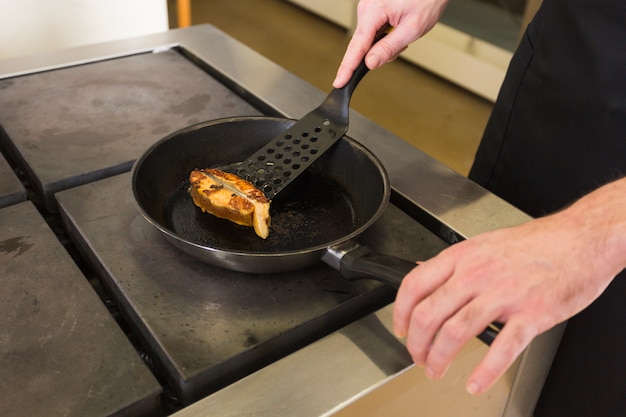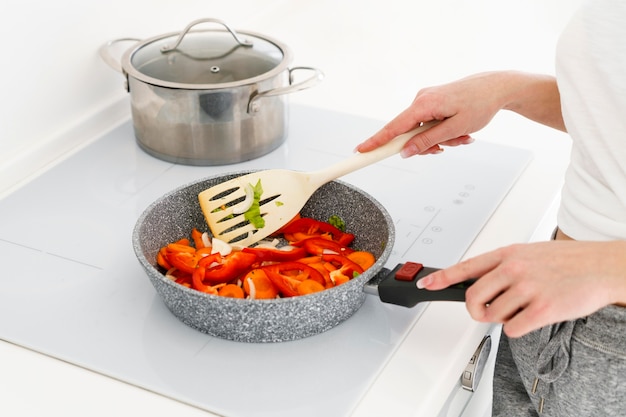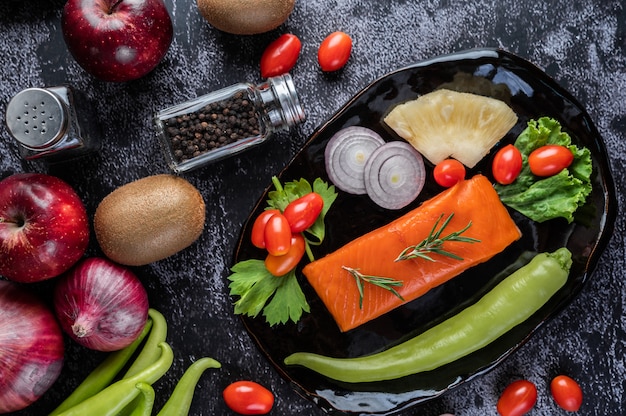There's something undeniably delightful about the taste of perfectly cooked salmon. Its delicate flavour, rich in omega-3 fatty acids, is a culinary treasure. But let's be honest, the joy of salmon goes beyond its taste; it's the ease of cooking that truly makes it a weeknight hero. A stunning pan-seared salmon can be whipped up in under 20 minutes, with minimal effort. The result is a meal that feels gourmet, even if you're not a seasoned chef.
However, achieving that perfect pan-seared finish – a golden-brown crust with tender, flaky fish inside – is where the magic happens. It's a delicate dance of heat, timing, and a touch of intuition. Today, we're diving into the world of pan-seared salmon, demystifying the process and revealing the secrets to getting that "just right" texture every time.
(Part 1) Why Pan-Seared Salmon?

Why pan-searing, you ask? It's a simple question with a profound answer: it's the absolute best way to bring out the natural flavour of salmon. Imagine the delightful experience: a crispy, golden skin that crackles with every bite, while the inside remains moist and juicy. It's a textural symphony, a culinary delight that's simply irresistible.
The Benefits of Pan-Searing:
- Simplicity in Action: Pan-searing is a speed demon in the kitchen, perfect for those nights when you're short on time. Think of it as a quick and easy way to transform your salmon into a delicious meal in a matter of minutes. You're looking at 10 minutes tops!
- Flavour Amplifier: Pan-searing creates a beautiful crust, a protective barrier that locks in the salmon's natural flavour. But the magic doesn't stop there! It's a blank canvas for your culinary creativity, allowing you to add a symphony of herbs and spices, transforming the flavour with every sprinkle. It's like a flavour explosion in your mouth!
- Culinary Chameleon: Pan-seared salmon is incredibly versatile, a chameleon of the culinary world. From simple salads to creamy pasta sauces, it seamlessly integrates into your favourite dishes, a testament to its adaptable nature. You can have it your way, every time!
(Part 2) The Tools of the Trade

Before we embark on our pan-searing journey, let's gather our tools, the trusty companions that will guide us to success. Having the right equipment is like having a secret weapon, making the entire process smoother and more enjoyable. So, let's arm ourselves with the essentials from our kitchen arsenal:
Essential kitchen tools:
- The Heart of the Operation: A Heavy-Bottomed Skillet or Pan: This is the cornerstone of our pan-searing success. A heavy-bottomed skillet or pan ensures even heat distribution, eliminating hot spots and ensuring that our salmon cooks evenly. It's all about creating a beautiful, consistent sear.
- The Gentle Touch: Tongs: These trusty companions are essential for flipping the salmon with care and precision. Think of them as the gentle hands that ensure the salmon doesn't stick to the pan. We treat our fish with respect, you know!
- The Perfectionist's Companion: A Thermometer: While optional, a thermometer is highly recommended for those who crave precision. It allows you to cook your salmon to your desired level of doneness, eliminating any guesswork. It's all about accuracy, darling!
(Part 3) choosing the right salmon

Now, let's turn our attention to the star of the show – the salmon itself. The quality of your salmon makes a world of difference, and choosing the right one is crucial for achieving that perfect pan-seared result. Here's a quick guide to help you select the perfect salmon for your culinary masterpiece.
Selecting the Perfect Salmon:
- Freshness: The Key to Success: Look for salmon with bright, shiny skin and firm flesh. The eyes should be clear and bulging, and the gills should be a vibrant red. These are signs of freshness, indicating a salmon that's bursting with flavour.
- Wild or Farmed: A Matter of Taste: This is a personal preference, but wild salmon often boasts a more intense flavour. It's a bit pricier but worth it if you're a salmon aficionado. farmed salmon is more readily available and typically has a milder flavour. Ultimately, it comes down to your taste and budget.
- Thickness: Achieving Even Cooking: For pan-searing, aim for salmon fillets that are about 1-inch thick. This ideal thickness ensures a good sear on the outside while the inside cooks evenly. It's the perfect balance for a truly satisfying meal.
(Part 4) Prepping the Salmon
We've got our tools and the perfect salmon, now let's prepare it for its starring role. This is where the magic really starts, the stage where we transform our salmon from raw potential to a culinary masterpiece. Here's a quick guide to prepping your salmon for pan-searing perfection.
Prepping the Salmon for Perfection:
- The Importance of Dryness: Pat It Dry: Pat the salmon fillets dry with paper towels. This crucial step helps the skin get crispy and prevents steam build-up during cooking. A dry surface ensures a beautiful, even sear, maximizing the crusty goodness.
- Seasoning with Love: A Symphony of Flavour: Season the salmon generously with salt and pepper. But don't be afraid to get creative! Add other herbs and spices like dill, garlic powder, paprika, or even a pinch of cayenne pepper for a touch of heat. It's your culinary masterpiece, so let your flavour imagination run wild!
- Skin-Side Down: The First Step to Success: If you're cooking the salmon with the skin on, place it in the pan skin-side down. This technique helps create a crispy skin and prevents sticking. Think of the skin as a protective shield, ensuring the fish cooks evenly and stays moist.
(Part 5) The Art of Pan-Searing
We've reached the heart of the matter, the stage where we unleash our pan-searing prowess. It's a thrilling moment, where patience and intuition come together in a culinary dance. Don't be intimidated by the process, it's simpler than you think! Follow these steps and you'll be a pan-searing pro in no time.
Perfect Pan-Searing:
- Building the Heat: A Sizzling Start: Heat your pan over medium-high heat until it's piping hot. You want that unmistakable sizzle when you add the salmon! The pan should be hot enough to create a crispy crust without burning the fish. This is where the golden-brown magic happens.
- Oiling Up: A Slick Start: Add a tablespoon or two of oil to the pan. Olive oil is a classic choice, but you can use another oil with a high smoke point, like avocado oil. The oil creates a barrier between the salmon and the pan, preventing sticking and ensuring an even sear.
- Introducing the Salmon: A Culinary Debut: Carefully place the salmon fillets in the pan, skin-side down. Don't overcrowd the pan; if you have multiple fillets, cook them in batches. Giving each fillet its own space allows for even cooking and a beautiful, consistent sear.
- The Sizzling Wait: A Culinary Patience Game: Cook the salmon for about 3-4 minutes per side, or until the skin is crispy and golden brown. Resist the urge to flip it too soon! Let that beautiful crust develop, allowing the flavours to intensify. It's a waiting game, but worth every minute.
- The Flip: A Moment of Truth: Use tongs to carefully flip the salmon over. You'll notice it starts to flake easily, a sign of perfect doneness. If you're using a thermometer, ensure the internal temperature is 125°F (52°C) for medium-rare. For well-done salmon, cook it to 145°F (63°C). The thermometer is your guide to culinary perfection.
- Rest and Enjoy: The Final Touches: Remove the salmon from the pan and let it rest for a few minutes before serving. This allows the juices to redistribute, resulting in a more tender and flavorful fish. It's a final act of culinary care that elevates the taste to new heights.
(Part 6) How Long to cook salmon: A Guide
The question on everyone's mind: how long do you actually cook salmon? Well, there's no one-size-fits-all answer. It depends on the thickness of the fillet and your preferred level of doneness. Here's a handy table to guide you through the cooking times:
| Thickness | Medium-Rare | Medium | Well-Done |
|---|---|---|---|
| 1/2 inch | 3-4 minutes per side | 4-5 minutes per side | 5-6 minutes per side |
| 1 inch | 4-5 minutes per side | 5-6 minutes per side | 6-7 minutes per side |
| 1 1/2 inch | 5-6 minutes per side | 6-7 minutes per side | 7-8 minutes per side |
Remember, these are just guidelines. Use your best judgment and don't be afraid to experiment. If you're unsure, it's always better to err on the side of undercooking than overcooking. You can always cook it for a bit longer, but you can't undo overcooked fish!
(Part 7) Tips for Perfect Pan-Seared Salmon
You've got the basics down, but here are a few extra tips to elevate your pan-searing skills to new heights, ensuring that every salmon you cook is a culinary triumph.
Pro Tips for Pan-Searing Success:
- Space is Key: Don't Overcrowd the Pan: If you're cooking multiple salmon fillets, ensure there's enough space between them. Overcrowding the pan prevents the salmon from getting a good sear and could lead to steaming instead of frying. Allow each fillet to breathe, creating a beautiful, even sear.
- Patience is a Virtue: Don't Flip Too Soon: Be patient and let the salmon develop a crust before flipping it. Resist the urge to flip it too early! It's a waiting game, but worth it! The crust is the key to locking in flavour and achieving that perfect texture.
- Keep a Watchful Eye: Monitor the Edges: Keep an eye on the edges of the salmon. If they start to brown too quickly, lower the heat slightly. You don't want burnt edges, sacrificing the delicate flavour of your salmon. It's about finding the perfect balance of heat and time.
- A Touch of Rest: The Final Step to Perfection: Once the salmon is cooked, resist the temptation to eat it immediately. Let it rest for a few minutes before serving. This allows the juices to redistribute, resulting in a juicier and more flavorful fish. It's a simple step that elevates your salmon to new heights of deliciousness.
(Part 8) Serving and Pairings
The final stage: serving time! Pan-seared salmon is incredibly versatile, a culinary chameleon that pairs beautifully with countless dishes. Here are a few ideas to inspire your creativity and tantalize your taste buds.
Serving Suggestions:
- Simple and Fresh: A Classic Pairing: Serve your salmon with a simple salad of mixed greens, cherry tomatoes, and a light vinaigrette. It's a perfect light and healthy meal, showcasing the salmon's natural flavour without overwhelming it.
- Creamy Goodness: A Comforting Combination: Pair it with creamy mashed potatoes or roasted root vegetables. It's a comforting and satisfying combination, creating a harmonious blend of textures and flavours.
- Mediterranean Flair: A Burst of Freshness: Top your salmon with a Mediterranean-inspired salsa of chopped tomatoes, cucumbers, red onions, and fresh herbs. It's a burst of fresh flavour, bringing a Mediterranean touch to your table.
- Asian Fusion: A culinary adventure: Try serving your salmon with sticky rice and a light soy-ginger sauce. It's a delicious fusion of flavours, offering a unique and exciting twist on the classic pan-seared salmon.
(Part 9) FAQs
Here are some common questions about pan-seared salmon, and the answers you need to create your culinary masterpiece.
1. Can I pan-sear salmon with the skin on?
Absolutely! Pan-searing with the skin on is actually a fantastic way to create a crispy crust and prevent the fish from sticking. Just ensure to cook it skin-side down first. The skin acts as a protective barrier, preventing the fish from drying out and ensuring a delicious, crispy texture.
2. What if my salmon is sticking to the pan?
Don't panic! If your salmon is sticking to the pan, it's probably because the pan wasn't hot enough or the salmon wasn't patted dry enough. Try increasing the heat slightly, or using a spatula to gently lift the edges. Don't force it, or you'll break the salmon. Gentle is the key!
3. How do I know when my salmon is cooked?
The best way to determine if salmon is cooked is to check the internal temperature with a thermometer. It should reach 125°F (52°C) for medium-rare. If you don't have a thermometer, you can check if the salmon is cooked by pressing on the flesh with a fork. It should be flaky and no longer translucent. Trust your senses, they'll guide you to perfection.
4. Can I cook salmon in a non-stick pan?
Yes, you can definitely cook salmon in a non-stick pan. Just make sure to use a light coating of oil so the salmon doesn't stick. Non-stick pans are a great alternative, offering convenience and ease.
5. What happens if I overcook my salmon?
overcooked salmon becomes dry and tough. It's best to err on the side of undercooked, as you can always cook it for a bit longer. But if you do overcook it, there's not much you can do. Just try to enjoy it anyway, and learn from your mistakes! You'll become a pan-searing pro in no time!
Everyone is watching

Perfect Rice Every Time: The Ultimate Guide to Cooking Rice
Cooking TipsAs a self-proclaimed foodie, I've always been a bit obsessed with rice. It's the foundation of countless cuisi...

Prime Rib Roast Cooking Time Chart: Per Pound Guide
Cooking TipsPrime rib roast. Just the name conjures images of lavish dinners, crackling fires, and hearty laughter. It’s ...

The Ultimate Guide to Cooking Asparagus: Tips, Techniques, and Recipes
Cooking TipsAsparagus. The mere mention of this spring delicacy conjures up images of vibrant green spears, crisp and burs...

Ultimate Guide to Cooking the Perfect Thanksgiving Turkey
Cooking TipsThanksgiving. Just the word conjures up images of overflowing tables laden with delicious food, the scent of r...

How Long to Bake Potatoes in the Oven (Perfect Every Time)
Cooking TipsBaked potatoes are a staple in my kitchen. They're incredibly versatile, delicious, and surprisingly easy to m...
